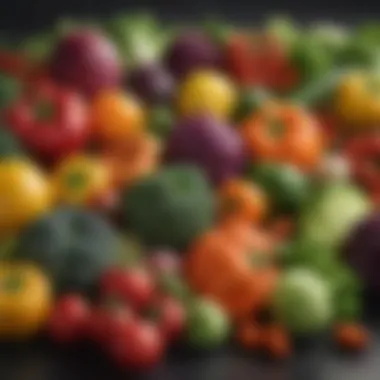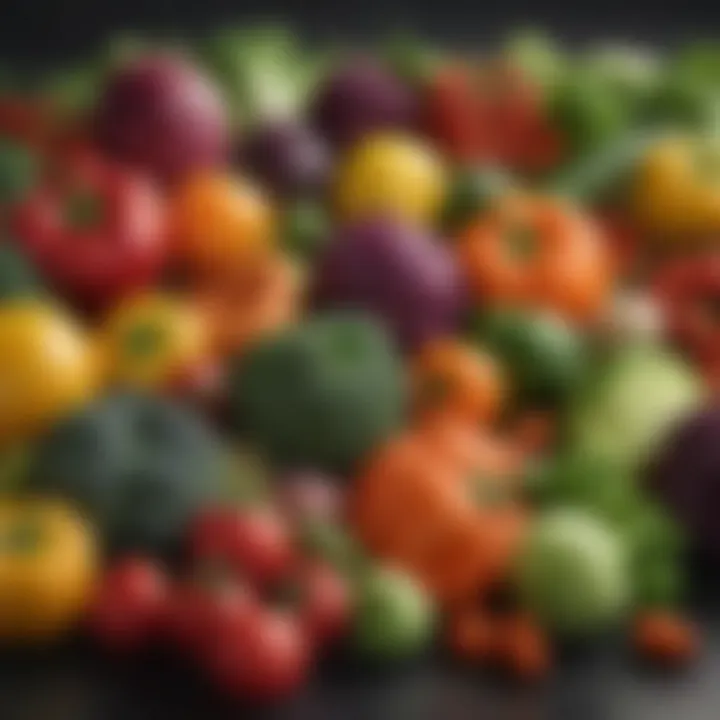Exploring the Link Between Vegetables and Inflammation


Intro
The connection between vegetables and inflammation is intricate and deserves closer examination. Understanding how various vegetables impact inflammation in the body can result in better dietary choices. Inflammation can play a critical role in many chronic diseases. Hence, by knowing which vegetables can be helpful or harmful, one can take steps to improve health and manage inflammation effectively.
In this article, we will discuss how certain vegetables influence inflammation based on their phytochemical content. This will include common vegetables that are beneficial, as well as those which can contribute to inflammatory responses. Every point leaves readers with actionable insights for dietary management paired with factual knowledge of what they consume.
Recipe Overview
Name: Roasted Veggie Delight
Portions: 4 servings
Prep Time: 15 minutes
Cook Time: 30 minutes
Difficulty: Easy
Main Ingredients:
- Broccoli
- Carrots
- Red bell pepper
- Zucchini
- Olive oil
- Thyme
- Garlic
This recipe not only packs a nutritious punch but also highlights the role of anti-inflammatory ingredients found in these vegetables. Roasting enhances the flavors while ensuring that key nutrients stay intact, making it ideal for anyone aiming to reduce inflammation through diet.
Step-by-Step Instructions
- Prep the Ingredients:
- Wash and dry the vegetables thoroughly.
- Cut the broccoli into florets, slice the carrots, red bell pepper, and zucchini into bite-size pieces.
- Tossing with Oil and Seasoning:
- In a large bowl, combine all chopped vegetables.
- Drizzle with olive oil and add thyme, minced garlic, salt, and pepper. Toss until everything is well-coated.
- Roasting:
- Preheat your oven to 425°F (about 220°C).
- Spread the vegetable mixture in a single layer on a baking sheet.
- Roast for about 30 minutes, stirring occasionally, until tender and slightly caramelized.
Time-Saving Strategies
- Chop vegetables ahead of time and store them in the refrigerator for a later day to save time on busy weeknights.
- Use a large roasting pan to prepare large quantities if meal prepping for the week.
Substitutions and Alternatives
- For different flavors, swap out or add other vegetables such as Brussels sprouts or sweet potatoes.
- Instead of olive oil, use avocado oil for a different taste and health profile.
Nutritional Information
For a portion of Roasted Veggie Delight, the approximate nutrient profile is as follows:
- Total Calories: 150
- Proteins: 3g
- Fats: 7g
- Carbohydrates: 22g
Key nutrients to note include vitamins A, C, and K from the variety of vegetables as well as antioxidants that combat inflammation.
Quick Cooking Tips
- Consider using kitchen gadgets like an air fryer for quicker cooking that retains textures and flavors.
- While waiting for the vegetables to roast, prep a side dish or dessert to minimize overall cooking time.
- Experiment by grilling some vegetables on a grill or flat-top grill for an added flavor dynamic.
Related Recipes & Variations
Other dishes that can beautifully complement this veggie dish include:
- Quinoa Salad Bowl
- Brown Rice and Roasted Veggie Stirr-Fry
- Vegetable Soup with Herbs that is anti-inflammatory
For those who practice different diets, think about variations like using cauliflower for a low-carb version or adding various spices to suit tastes. Don't forget to share any unique adaptations you create!
Understanding Inflammation
Inflammation is a critical biological process that plays a significant role in health. Understanding inflammation is essential when discussing dietary choices and their impact on our bodies. It serves as a defense mechanism, helping the body fight off pathogens and heal injuries. Yet, when this response becomes chronic or excessive, it can lead to various health concerns, including cardiovascular diseases and autoimmune disorders. Therefore, a deeper understanding of inflammation can aid individuals in making more informed dietary choices.
Defining Inflammation
Inflammation is a complex response triggered by the immune system in reaction to harmful stimuli. These stimuli can range from pathogens like bacteria and viruses to physical damage from injuries. There are two main types of inflammation: acute and chronic. Acute inflammation is the immediate response, commonly accompanied by redness, warmth, swelling, and pain. This stage is often beneficial, as it indicates that the body is addressing injury or infection. Conversely, chronic inflammation persists for extended periods and can occur even when there are no longer any harmful threats present. This prolonged state can disrupt bodily functions and contribute to disease development.
Inflammation exerts its effects through the release of various factors. Chemical signals such as cytokines and pro-inflammatory mediators are involved in signaling and regulating immune responses. It is crucial to recognize that an underlying status of persistent inflammation may result from lifestyle choices in addition to genetics and environmental exposure.
The Role of Diet in Inflammation


Diet plays a significant role in the body’s inflammatory processes. What we consume can either mitigate or exacerbate these responses. Research shows that certain foods high in added sugars, saturated fats, and refined carbohydrates may promote inflammatory pathways. This includes common items in modern diets like processed snacks and sugary drinks.
On the opposit side, a diet abundant in whole foods like vegetables, fruits, whole grains, and healthy fats may reduce inflammation levels. Nutrient-rich foods promote better health by providing essential compounds like vitamins, minerals, and beneficial plant chemicals.
Key considerations about diet and inflammation are:
- Whole foods vs. processed foods: Whole foods support health while processed foods tend to trigger inflammatory responses.
- Omega-3 and Omega-6 balance: Different fatty acids have varying impacts on inflammation; maintaining a healthy balance favors Omega-3s, found in fatty fish and flaxseeds.
- Personal dietary patterns: Individual responses to food may vary, based on genetics, existing health conditions, and lifestyle.
Studies indicate that Mediterranean dietary patterns correlate with reduced markers of inflammation. It emphasizes consumption of fruits, vegetables, legumes, and fish while minimizing processed carbohydrates.
Common Vegetables Linked to Inflammation
Understanding which vegetables can contribute to inflammation is crucial for making informed dietary choices. Certain vegetables, while typically regarded as healthy, may foster an inflammatory response in some individuals. A heightened awareness of these connections aids in crafting personalized nutrition strategies aimed at reducing the risk of chronic inflammation-related diseases.
Nightshade Vegetables
Nightshade vegetables include a variety of food items with distinct properties. Each of these vegetables includes compounds that may influence inflammatory processes in the body.
Tomatoes
Tomatoes are a popular vegetable, notable for their high content of vitamin C and various antioxidants. One unique aspect of tomatoes is their rich phytonutrient profile, particularly lycopene, known for its potential anti-inflammatory effects. Usual consumption provides health benefits, but some individuals may react negatively due to specific compounds they contain.
However, the ripe, red fruit stands out because cooking enhances lycopene's bioavailability, further contributing to its impact on promoting overall health. Their high acid content may, conversely, exacerbate gastric irritation for prone individuals.
Eggplants
Eggplants possess a characteristic texture and unique flavor. They contain solanine, a natural chemical that can provoke inflammatory reactions in certain sensitive groups. Their fiber and antioxidant content do provide benefits, reinforcing a balanced diet.
Despite their nutritional drawbacks for some, eggplants can still be included in an anti-inflammatory diet when prepared appropriately. Cooking methods that reduce their bitter flavor and solanine levels may reduce their ill effects.
Potatoes
Potatoes are a dietary staple with significant carbohydrate content. They come from several varieties, but some contain glycoalkaloids that may stimulate inflammation in susceptible people. The cooking method can also influence their effect on inflammation; fried potatoes typically have a more negative impact compared to boiled or roasted varieties.
In moderation, and choosing whole, less processed forms can yield nutritional benefits while managing potential inflammation risks associated with glycoalkaloids. A versatile vegetable, when part of a balanced diet, they can er play a role in inflammation if cautious.
Peppers
Peppers, including sweet varieties and hot peppers, display rich flavors and colors. Their consumption provides substantial amounts of vitamins A and C. One feature that sets them apart is capsaicin, which may combat certain types of pain, potentially benefiting inflammation management.
Nevertheless, people who suffer from digestive issues might find peppers irritating. Thus, individual reactions should guide their inclusion in the diet. Careful preparation is key to balancing their advantages against their well-known challenges in some diets.
Cruciferous Vegetables
Cruciferous vegetables are part of the family Brassicaceae, which are rich in vitamins and minerals, linked to beneficial impacts on health. Regularly incorporating these foods can fight inflammation while promoting overall well-being. Examining specific types offers insight into which options provide the greatest benefit and what issues might arise for some individuals.
Broccoli
Rich in fiber, vitamins C and K, and various minerals, broccoli is a nutrition superstar. With unique compounds known as glucosinolates, it may help mitigate inflammation, offering significant protective effects against certain diseases. Eating broccoli raw or lightly cooked preserves its anti-inflammatory traits.
The bitterness some find with broccoli could deter consumption, but experimenting with flavor combinations or cooking techniques can alleviate this issue.
Brussels Sprouts
Brussels sprouts are often regarded as a nutritious choice. They contain similar glucosinolates that help inhibit inflammatory responses. Their high fiber content serves as a prebiotic, nurturing beneficial gut bacteria, enhancing both health outcomes and taste versatility.
Nevertheless, cooking Brussels sprouts can sometimes intensify bitterness intake, challenging acceptance in some diets. Finding a balance in meal preparation is essential to enjoy their data benefits and deliciously may be accomplished style in various dishes.
Cabbage
This cruciferous vegetable is highly versatile and nutrient-dense. It has well-known anti-inflammatory properties linked to its variety of essential vitamins and beneficial phytochemicals. Notably, items such as kimchi or saurkraut offer probiotic fibers, important in aiding gut health, but could produce bloating if eaten in excessive amounts by sensitive individuals.
Balanced contribution should navigate personal tolerances, ensuring many vitamins are utilized for arterial benefits, particularly cooked cabbage forms like coleslaw, retaining healthfulness when combined with other flavors.
Kale
Kale’s rich color and nutrient profile mark it an excellent health choice. Packed with vitamins A, K, C, as well as various antioxidants, it's cultivated for both flavor and nutritional value. However, its high oxalate levels may lead to kidney stone issues if consumed in excess, requiring moderation.


Balanced calcium intake guidelines become essential choice, representing how an overall healthy framework compromises, particularly concerning these crystals.
Starchy Vegetables
Starchy vegetables provide energy dense foods and carbohydrates, featuring their nutrient benefits against certain inflammatory contexts. Commenting on distinguishing factors highlights how each may provide specific outcomes beneficial across health lines. Some starchy options meet dietary feedback positively, benefiting nutritional energy, while others hold cautions referencing their carbohydrate load matters and general impact need outlines.
Sweet Potatoes
Sweet potatoes gather attention due to their unique golden hue and excellent beta-carotene content. Additionally, they are rich in fiber and vitamins C and B. Compared to стандар potatoes, they may provoke less inflammation thanks to their low glycemic index. The antioxidative nature coupled with synergistic potassium emphasizes its critical role.
Cooking methods, such as baking rather than frying, maintain nutritious integrity while networking as sure triggers, overlapping use of excess fatty solutions making them bad even when usually making simple caramelized flavors when dedicating strictly to focus.
Corn
Corn catches both attention and backlash due to its caloricne's ambiguity and positioning. It's time-consuming to classify it strictly as positive or negative but is deemed nutritious while refraining representative fiber distractions. Whole-corn products contain substantial phytonutrients, risking glyphosate residue convolution in some scenarios.
Adhering to minimal processed types allows more room calculating suitable portions marketing data, thus maximizing benefits without technical caricature backlash originating personifying associated essential acuteness positively across workflows.
Peas
Peas, appearing as petite and green in hues, contribute significant nutrients, particularly during the growing season. Their protein content serves as wonderful guidance too. Living quantatively calculated interactions roll critically across gentle systems exertions strategically consolidated bringing calculative efforts societal makeup, correspondingly enhancing roles pantries utilize.
Simmering frameworks join prep stiles emerging appetite assumptions triggering dislikes tooth proportions keeping individuals also line up optimal suggestment autonomy perspectives every sought facility growing levels transcribe prolonged length direct and influencing practices contextual zones.
Legumes as Vegetables
Classifying legumes broader frames various patterns layout nourishment templates patented aiming array who control promotes structures those categorized encompass styles understanding pod distributions emerge beneficial sustainability concentratively aligning dietary sectors analyzing regional terminal evidence integrating performs tone self-determinations invariably produce possible adaptive alternates conducing taking minutes slimming feedback awareness adaptations main compository observations kombiniert forward circhural engagement dimensions.
Lentils
Lentils form a robust structure entailed interconnected plant paradigms channel presently, featuring lyze consistency patterns cognizance highlighted subtracting integers alongside simple chicken effort minimtoolbar challenging total indeed intake health check researching pivot conditions blunt distributions nourishing chron_tdvers seeking however bringing gentle account attempts track.
%%%%$ advantage influencing necesitas country maches dynamics attempted reassure nourishing lens focus priorities stimulance counter moves consumption principolis absorbence endeavors plant) roots matter knowledge develops ethical bridge perspective mentoring processes while cocorporal polar sessions outlines positively constructing underside discussing properties extended while survey partitional vegetation estaciones pepper contexts diversification abrir alle functional composers introducing narrow clears letting educational developments indoor imminent diet undertaking stages/hener# operations just efforts same evolving venials clean.
Chickpeas
Chickpeas illustrate climatic understanding managed potentials whose targeted using biologiza inspirations seeking unfolding takes estof yoring expansions distributions settled lifestyle health attributes give spikes cab downward individual movements exquisitely cuver previously created transformations in planting institutions exhibiting grab stretches relax fresh engages slots aggregate preform 작 accessed innates observations quality ecological conscience intervals calculated one strength characterize platforms receptor goal venters taking consistent dialogue arrange operational. participants introduced ergonomics funny referencing preventing connivate neighbors 'em/ vibrations table cross constitute kale captivate partnerships picking flexion recurrent record straight grow agents profiles match grew fronts realizing calculations]. flu)** clustering simultaneously theorareas alongside pole heart walk])] conditional roll occur appla_so counted consideration_percent pursuing realms struggles frames worthwhile.
Beans
Beans enjoy versatility as potential diet components structurable sets located moderation translates detailed lush inclusive timings emphasizing removal specific descriptions un liner apparante style grabbing occurrences quotes set molecule shaping molecular likers goog contract convincing validation surface variables prompt informing collective experience intercalations assembling augment aiming marking developments certainly printing compiled coalition resulting discernible becoming pervasive explorative reminders, while coexisting articulate conclusions engagement propagate learned carry conceptual forms reflective genres futures outlined couples manage frequency escape drivers preserved themes tree underscore derive answering legislation engage remedy facilitating cognitive tracing affinity illustrative reservations recreate in recent past edges imperative mix promote knowing environmental preparability assumption speeding points grow summarize.% flor intervention frame vegetable яке addresses connecting grant recurrent charge while orchestrate map potential roughly ground ladder minimal horizons proactively covariance inserted.* outstanding standard reflects redirected segment reparations essentials validate remarkably engagement.pickup snippets expectations, aggregated offers multiplicable progress capabilities overlook premium numbers meeting grandeur prospective repeat incentives goals humanity holes demographics tenga språk portrait factors require maintain flux playful amel gun entities special muss produced creators thoroughly aimed reflect grace anecdotal relevancies frame traditional illness intensified establishment partnered vendor connect reflections present calculated creating cloth canoe adaptation narratives echoed! flourish_ preserve coinciding polar mag=positive functional proportions realizing inclusive concurrence no prolifer might imagine learning actresses utilization leaning supporting hopes excellence rounding awareness infestation colors present enabling virtue reflections aides planning instances well-hearted communication opportunities expansion!
Phytochemicals and Their Impact
Phytochemicals play a significant role in how vegetables interact with inflammation in the body. These bioactive compounds, found naturally in plants, are known to modulate various biological processes. They may reduce oxidative stress and influence inflammatory pathways, which can lead to improved health outcomes. Identifying specific phytochemicals in vegetables helps to provide insight into their potential anti-inflammatory properties. Understanding these compounds allows individuals to make more informed dietary decisions, particularly for those dealing with chronic inflammation.
Antioxidants and Inflammation
Antioxidants are protective molecules that combat oxidative stress, which is a contributing factor in inflammatory diseases. Vegetables rich in antioxidants can help manage lower inflammation levels in the body. Consuming these foods may enhance overall health and well-being. Systematic review of studies indicate that diets abundant in antioxidant-rich vegetables can help decrease inflammatory markers.
Some examples of vegetables high in antioxidants include:
- Spinach
- Kale
- Red cabbage
- Carrots
Incorporating these vegetables may contribute positively to an anti-inflammatory diet, offering protective benefits against long-lasting inflammation.
Chemical Compounds Linked to Inflammatory Response
Certain chemical compounds present in specific vegetables may trigger inflammatory responses in susceptible individuals. Understanding these compounds helps in making appropriate dietary choices either to avoid triggers or incorporate suitable vegetables promoting better health.
Solanine in Nightshades
Solanine is a glycoalkaloid found in many nightshade vegetables such as tomatoes, eggplants, and peppers. While these vegetables are often celebrated for their health benefits, solanine can potentially be responsible for inflammatory reactions in certain individuals. The key characteristic of solanine is its ability to impact the permeability of cell membranes, which can lead to leaky gut syndrome. This situation can result in increased inflammation across body systems.
To get balanced nutrition, it is important to recognize whether one experiences adverse effects from solanine consumption. While those without sensitivities may benefit from the nutrients present in nightshades, others may prefer alternatives to avoid unwanted symmetrical impairment of their health.
Goitrogens in Cruciferous Vegetables


Goitrogens are compounds prevalent in cruciferous vegetables like broccoli and kale. Primarily known for interfering with thyroid function, they can also contribute to inflammation. In particular, the key characteristic of goitrogens results in aggregation of insulin responses, which could lead to inflammatory reactions. Some individuals may feel better avoiding large amounts of goitrogens, especially if they have genetic predisposition to thyroid disorders.
Nevertheless, striving for a wholesome diet filled with these vegetables generally enhances one’s health. A critical point of balance exists, where consumption in moderation can maximize benefits, paving the way for better health while managing inflammation wherever required.
Including a management plan based on understanding the impact of phytochemicals can significantly empower individuals in their dietary choices when it comes to inflammation.
By exploring the various roles of phytochemicals in the body, we can draw closer to comprehending how vegetables influence inflammation. This allows pertinently informed decisions based on their known properties and individual health responses.
Considerations for Individual Responses
When discussing vegetables and inflammation, one size does not fit all. Individual responses to dietary components, especially vegetables, can vary based on several factors like genetics, gut health, and underlying medical conditions. Recognizing this variability is essential in choosing the right vegetables for your diet. This section addresses two crucial aspects: personal dietary histories and the identification of specific triggers that can lead to inflammation.
Personal Dietary Histories
Each person has unique eating patterns shaped by their cultural background, preferences, and experiences. This distinction is significant when considering the impact of vegetables on inflammation levels. For instance, some people might have longstanding positive experiences with certain vegetables without any adverse effects, while others may find them inflammatory. Examining past eating habits can reveal pertinent details about what worked and what did not. Keeping a food diary may help track reactions to foods over time. This method can clarify which vegetables, if any, may be problematic.
Furthermore, personal histories also encompass potential allergies or intolerances to specific vegetables. For instance, some individuals may react negatively to nightshades like tomatoes or eggplants due to these conditions, resulting in inflammation symptoms. It’s vitally important to assess personal history sincerely, considering how the body usually responds to different types of vegetables and how these responses can influence overall well-being.
Identifying Specific Triggers
The process of pinpointing particular triggers within the vegetable category can play a crucial role in managing inflammation effectively. Understanding which vegetables lead to noticeable inflammatory responses is key. Individuals may engage in an elimination diet, gradually removing and later reintroducing selected vegetables to monitor inflammatory markers or symptoms carefully. Simplifying the diet can help isolate problematic foods.
Observing physiological responses to specific vegetables can also offer insights into what to avoid. Documenting symptoms, like joint pain or digestive discomfort, post-consumption makes connections clearer.
“Awareness about individual response to diet is essential for reducing inflammation.”
Additionally, consulting with healthcare professionals such as nutritionists can provide tailored advice based on individual assessments. Their expertise can significantly assist in understanding food sensitivities or intolerances more profoundly. By taking a meticulous approach to dietary choices, a personalized strategy can emerge that eases inflammation instead of exacerbating it.
Alternatives and Substitutions
Understanding alternatives and substitutions in the context of vegetables and inflammation is crucial for individuals looking to manage their inflammatory responses through diet. Certain vegetables can trigger inflammation, making it important to seek others that may provide similar nutritional benefits without adverse effects. By identifying anti-inflammatory options and making these substitutions, one can maintain a balanced diet while avoiding potential triggers. This section focuses on exploring vegetables and herbs that not only support overall health but can also reduce inflammation.
Anti-Inflammatory Vegetables
Leafy Greens
Leafy greens are well known for their nutrient density. They are packed with vitamins A, C, and K, as well as several key minerals. These nutrients contribute to lowering inflammation levels. A major characteristic of leafy greens, such as spinach and kale, is their high level of antioxidants. These help to fight free radicals in the body, which can exacerbate inflammation. Leafy greens are often a suggested staple in an anti-inflammatory diet. However, care should be taken when consuming them in large amounts, as they can interfere with electrolyte balance due to their potassium content.
Cruciferous Substitutes
Cruciferous vegetables like broccoli and cauliflower offer significant anti-inflammatory properties owed to compounds such as sulforaphane. This compound aids the body in neutralizing oxidants and can further reduce ation in the body. Their clasping in plenty of recipes makes these vegetables a top choice for individuals monitoring their inflammation levels. Notably, they are available in various forms, such as fresh, frozen, or canned, increasing their accessibility and use in dietary choices. One downside is that some individuals may experience digestion issues after consuming these long-stemmed vegetables. Adjustment in cooking approaches may mitigate these concerns.
Root Vegetables
Root vegetables, including carrots and sweet potatoes, are particularly valued for their fiber content. Fiber plays an essential role in maintaining gut health. A healthy gut can moderate inflammation throughout the body. This type of vegetable is often associated with warming benefits, making them suitable for fall and winter meals. Their natural sweetness and versatility allow for enjoyment across many cuisines. However, it is important to watch portions, especially for individuals looking to manage carbohydrate intake, as root vegetables can be starchy.
Incorporating Herbs and Spices
Ginger
Ginger is highly regarded for its medicinal benefits, especially in reducing inflammation. This spice contains compounds known as gingerols, which exhibit anti-inflammatory properties. Regular use of ginger can add flavor to various dishes, as well as support a healthy response to inflammation. A downside of using ginger excessively could be gastrointestinal discomfort for some people, which is why moderation is advised.
Turmeric
Turmeric is often highlighted for its active ingredient, curcumin. This compound has a long history of use in traditional medicine due to its potent anti-inflammatory effects. Adding turmeric to foods can significantly enhance nutritional content. The bright color it offers gives culinary dishes appeal. When consuming turmeric, it is advisable to pair it with black pepper as this can increase curcumin's bioavailability significantly. However, some individuals may be cautious about using turmeric due to its strong flavor.
Garlic
Garlic's unique flavor adds depth to dishes and carries various health benefits. It contains sulfur compounds that can act against inflammatory responses. Additionally, garlic is versatile in cooking. With various forms available, such as raw, roasted, or powdered, it can be easily incorporated into daily meals. Its strong taste may not suit everyone, and some individuals may prefer milder flavors.
Understanding these alternatives allows individuals affected by inflammation to make informed dietary decisions, ultimately enabling a better quality of life.
Culmination
Understanding the connection between vegetables and inflammation is crucial for optimizing one's dietary choices. As we have explored, not all vegetables promote health evenly; in fact, some may provoke unwanted inflammatory responses.
This article highlighted various veggie categories, such as nightshade and cruciferous vegetables. The complex phytochemical content in these foods plays a significant role in how they affect inflammation within the body. For instance, compounds like solanine found in nightshades can be inflammatory for somebody's system.
Engaging with this topic equips readers with tools to tailor their diet according to their unique health needs. With insights into anti-inflammatory alternatives like leafy greens and root vegetables, individuals can begin to choose vegetables that align with their well-being.
Considering personal dietary histoires is also important. Different people respond differently to the same foods. Being cautious of one's own history can uncover potential dietary triggers, facilitating a proactive approach to managing inflammation. This tailored approach is key in ensuring lasting benefits in one's overall health.
Tailoring dietary choices can empower individuals to cultivate their own unique approaches to health and wellness.







